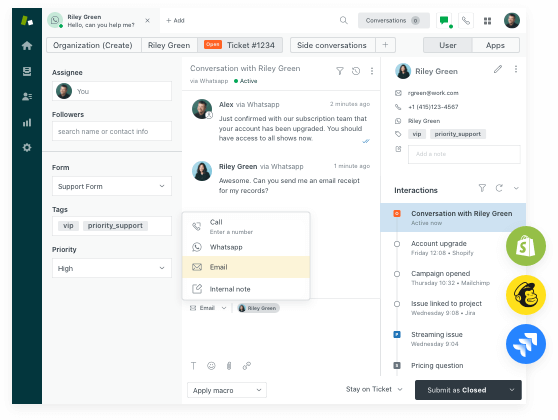Virtual call center software
Where ever they are, your agents and customers deserve the best virtual call center software

A guide to the best virtual call center software
虽然cha倾向于关注更新的服务nnels, like social media and live chat, telephone support remains a customer service mainstay.As recently as 2020,大多数(66%)报告说,他们typicall客户y resolve issues with a company via telephone.
That in itself is enough to tell you that your virtual call center software is key to your service operation. But a virtual call center isn’t just valuable for customers, it’s also about giving your agents the flexibility they value so much. With so much on the line, it’s worth taking the time to walk through everything you need to know about virtual call center software, including the ten best options for 2022.
- What is virtual call center software?
- How is a virtual call center different from a traditional call center?
- A comparison chart of the best virtual call center companies
- Top 10 virtual call center software
- What are the essential features of a virtual call center software?
- What are the benefits of using a virtual call center service?
- How to choose the best virtual call center solution for your business?
- Frequently asked questions
- 试试虚拟帐目ct center software for free
What is virtual call center software?
Virtual call center software is an application that facilitatesinbound and/or outbound callingin multiple, distributed locations. In a virtual call center software instance, agents can receive and make phone calls from their homes or in regional offices. Other than its distributed nature, virtual call center software functions in the same way as traditional call center software.
Just like traditional call center software, you can use virtual call center software to handle large call volumes throughcall routing, pre-recorded answers,call transferring, and much more.
How does a virtual call center work?
Once you’ve deployed your virtual call center software, all your agents need to do is log in, learn the system, and get to work. For a virtual call center to work, your agents need a computer and a reliable internet connection, and perhaps a headset. The call center works depending on how you set it up but generally speaking, you can use the software to collect caller data, configure call flows, provideself-service menus, and match call records with existing customer records.
When do you need a virtual call center?
If your organization has remote employees that regularly field or make large volumes of inbound or outbound calls, you need a virtual call center. Companies that currentlyuse outsourced call center servicesmay also benefit from implementing a virtual call center service. In short, when you need to automate call handling processes and improve the quality of your phone customer service, you’d benefit from a virtual call center.
How is a virtual call center different from a traditional call center?
The most obvious difference between virtual and traditional call centers is that the former enables agents to work from anywhere. This is because the technological capabilities of virtual call center softwareexist in the cloud, rather than in a server that’s only accessible from one location.
However, the fact that virtual call centers reside in the cloud isn’t just about accessibility. Because with cloud-based software, there are far more possibilities when it comes to integrating other systems and data. Whereas integrating data from traditional call centers intocloud-based CRMmight require costly configurations, in many cases the same can be done in virtual call centers with pre-built integrations.
A comparison chart of the best virtual call center companies
| Software | Starting price (/user/month) | Free trial | Key Features |
|---|---|---|---|
亚博 |
$49 |
|
|
Aircall |
$30 |
|
|
CloudTalk |
$25 |
|
|
TalkDesk |
$75 |
No |
|
Five9 |
N/A |
No |
|
NICE CXone |
N/A |
|
|
Ameyo |
N/A |
No |
|
8×8 |
$125 |
|
|
Genesys |
$75 |
|
|
Bright Pattern |
N/A |
|
Top 10 virtual call center software
1.亚博

Embedded within Zendesk’sindustry-leading ticketing systemis virtual call center software that is designed to facilitate a seamlesscustomer experience.Regardless of the number and variety of service channels, Zendesk has a plan with the capacity to meet your needs. Even better, our packages are assembled to provide the capabilities necessary to help teams of any size resolve issues faster right out of the box.
Plus, since we (and you) are in this for the long haul, Zendesk comes equipped with the tracking and monitoring tools you need to optimize your operations over time.
A platform for your agents to thrive
The agent experience directly impacts the customer experience. When your agents have to frantically click through multiple tabs to take notes, log conversations, or access customer data, they can’t focus on the customer in front of them. And their ability to quickly address issues suffers. But when agents can handle voice supportin the same workspace as all other channels, and they have access to full customer context, they can quickly get to the crux of customers’ most complex and urgent issues.
Quick time-to-value without sacrificing customizability
However you choose to deploy Zendesk, you can do so much faster than you can with any other platform without sacrificing extensibility. With Zendesk’s ability to integrate with more than 90 telephony providers, you can easily plug in your preferred call center solution. Or you can use Zendesk as your standalone telephony provider. Either way you go, you can then build on your voice capabilities with additional tools and services such as advanced call transcription, redaction, and quality assurance capabilities.
Measure and improve your voice support
Your agents’ conversations with your customers are a goldmine of information. Yet traditional call centers make this information difficult and costly to collect. Not so with Zendeskwhich is equipped with useful tracking tools like call recording, queue volume metrics, andreal-time reporting.
Using these tools and others, your managers and agents can easily see what aspects of your call center operations are working well and where there’s room for improvement. Plus, with call recordings, managers can sit down with agents and provide detailed feedback with real example scenarios to analyze. At a higher level, you can also use Zendesk’s cross-channel reporting to compare voice performance against messaging, email, chat, and other conversational experiences.
Pricing Plans:
- Suite Team: $49 user/month
- Suite Growth: $79 user/month
- Suite Professional: $99 user/month
- Suite Enterprise: $150 user/month
Free trial: 14 days
Features of Zendesk Suite Team
- Voicemail
- Text messaging
- group call routing
- Display a number on web widget
- call forwarding
- Caller ID
- Failover
- Customized greeting
- Automatic ticket creation
- Mute, hold, and warm transfer
- Omnichannel support
- Call recording
- 90+ telephony providers
- APIs,SDKs, andintegrations
2.Aircall
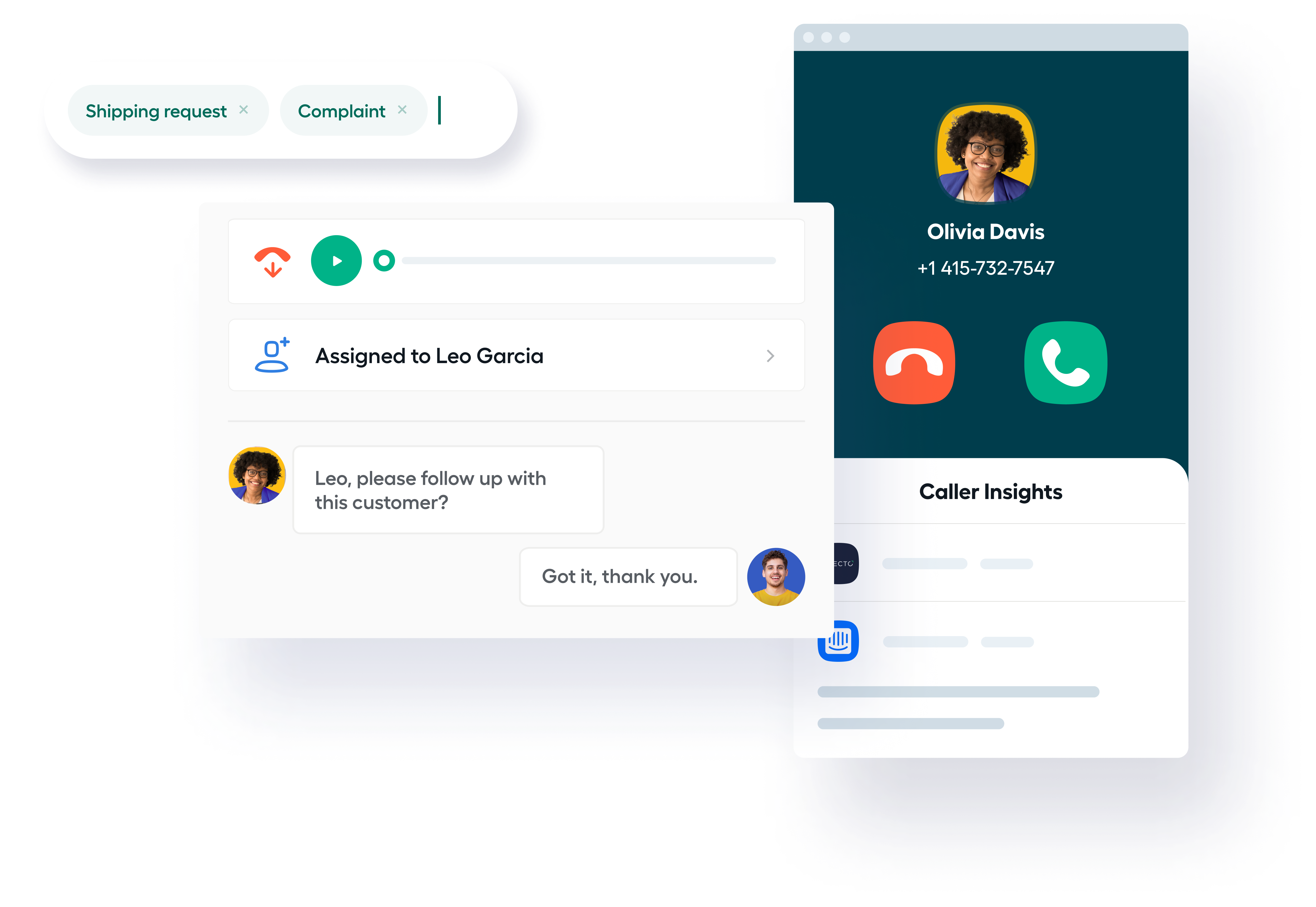
Aircall is a popular virtual call center solution that claims to be as simple to set up as managing your email. E-commerce brands and software companies alike use Aircall to deploy basic call center capabilities like call routing and IVR as well as more advanced features like Power Dialing and CRM integrations. You can also use Aircall to craft automations, analyze call data, and integrate with your other tools.
A common theme in negative reviews about Aircall is the pace and efficiency of the onboarding process. SeveralG2 reviewers noted that Aircallsupport staff seemed “hands-off” and “slow”. The more positive feedback centered around Aircall’s ease of use and effective integrations.
Aircall’s vertical call center plans all include unlimited inbound and outbound calling within the US and Canada. A 7-day free trial is available and their plans start at $30 per user/month.
Pricing Plans:
- Essentials: $30 user/month
- Professional: $50 user/month
- Custom: Call for details
Free trial: 7 days
Features of Aircall Essentials
- API and 95+ integrations
- Call recording
- IVR
- Unlimited calling in the US and Canada
- SMS
- Click-to-dial
- Call queuing
Learn more about Zendesk for Aircall.
3.CloudTalk

Growing businesses need virtual call center software that can expand with them. In that respect, CloudTalk fits the bill with phone numbers for more than 140 countries throughout the world. Large, multinational logistics companies, car manufacturers, and retailers trust CloudTalk as their virtual call center software of choice.
CloudTalk includes all the basic and advanced features you’d expect and need from your software. Call queuing, call recording, extensions, SMS support, personalized greetings, and much more come standard in every plan.
CloudTalk plans range in price from $25 to $50 per user/month. Worth noting though is that if you need to enable outbound calling, you’ll have to purchase a Custom plan which includes unlimited outbound calls billed at a flat rate.
Pricing Plans:
- Starter: $25 user/month
- Essential: $30 user/month
- Expert: $50 user/month
- Custom: Call for details
Free trial: 14 days
Features of Cloud Talk Starter Plan
- Unlimited inbound and intracompany calls
- Click to call
- ACD
- Mobile app
- International numbers for 140+ countries
- Unlimited call queues
- Call recording
- Call flow designer
Learn more about Zendesk for CloudTalk.
4.TalkDesk
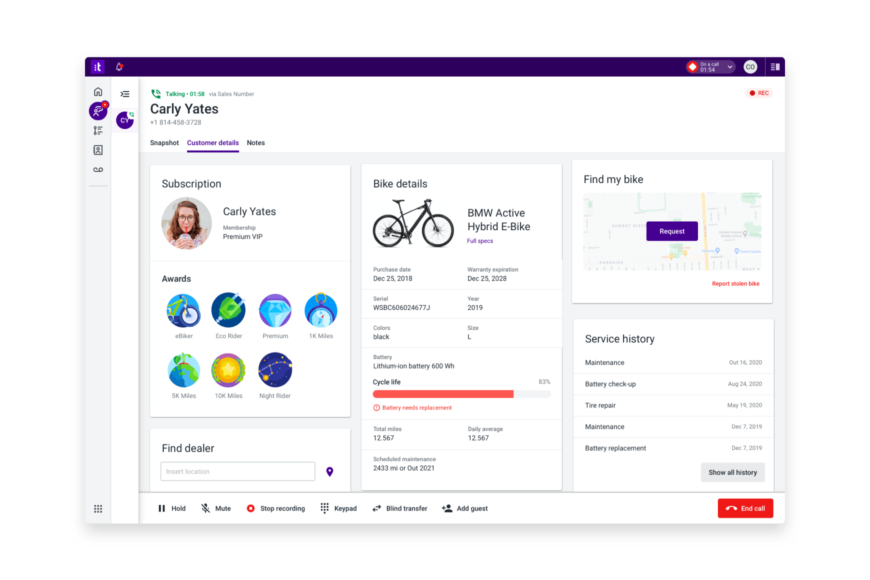
Although TalkDesk’s website features many different products, the software is primarily a virtual call center solution. In addition to its core virtual call center functionality, TalkDesk includes a self-service portal, workforce management capabilities, employee collaboration tools, and robust CX analytics. Plus, the mobile app enables sales and service reps to make and receive calls from anywhere.
G2 reviewers give TalkDeskhigh ratings, with many customers highlighting the solution’s easy-to-use interface, valuable reports, and simple implementation. However some customers have noted that the analytics and call recording in TalkDesk leaves something to be desired. Pricing for Talkdesk starts at $75 per user/month and tops out at $125 per user/month and there is no free trial.
Pricing Plans:
- Essentials: $75 user/month
- Elevate: $95 user/month
- Elite: $125 user/month
Free trial: Not available
TalkDesk CX Cloud Essentials Plan Features
- Talkdesk Studio
- Real-time dashboards
- API access
- Knowledge management
- 60+ out-of-the-box integrations
- Virtual agent
Learn more about Zendesk for Talkdesk
5.Five9
Restaurants, retailers, and professional service providers all use Five9 to power their call centers. The ability to manage customer relationships across voice, email, social, SMS, video, and more mean Five9’s virtual call center software is worth considering for brands with many different service channels.
Seamlessly stitching your call center software to the rest of your customer experience can mean the difference between good and great customer service. Plus, Five9 offers other phone solutions if you need to expand internally or externally. While pricing is not available for Five9’s packages, you can expect no-fee long-distance calling on all their packages.
Pricing not available
Free trial: Not available
Features
- Omnichannel ticket routing
- IVR
- ACD
- Real-time and historical dashboards
- Predictive dialing
- Intelligent virtual assistant
- Outbound dialer
- Call recording
- Web call back
- Workflow automation
Learn more about Zendesk for Five9.
6.NICE CXone
Our research in 2022showed that 61 percent of customers do not give a company a second chance when their service doesn’t meet their expectations. So it’s disconcerting to see many G2 reviewers noting how NICE CXone tends tocrash when the volume is high.However, when NICE CXone is functional, its capabilities are powerful.
NICE CXone features quality management and resource planning tools along with call center analytics, business VOIP, and automated call routing. Large, sophisticated organizations like Visa, American Airlines, UnionBank, AAA, and more trust their call center software to NICE CXone.
Unfortunately, NICE doesn’t publish its pricing. You’ll have to make contact with the company to get information about licensing and implementation costs.
Pricing not available
Free trial: 60 days
Features
- Workforce management
- Live chat
- Reporting
- Native integrations
- Self-service knowledge base
- Workforce management tools
- Customer feedback surveys
- Live chat software
Learn more about NICE inContact CXone Agent for Zendesk.
7.Ameyo
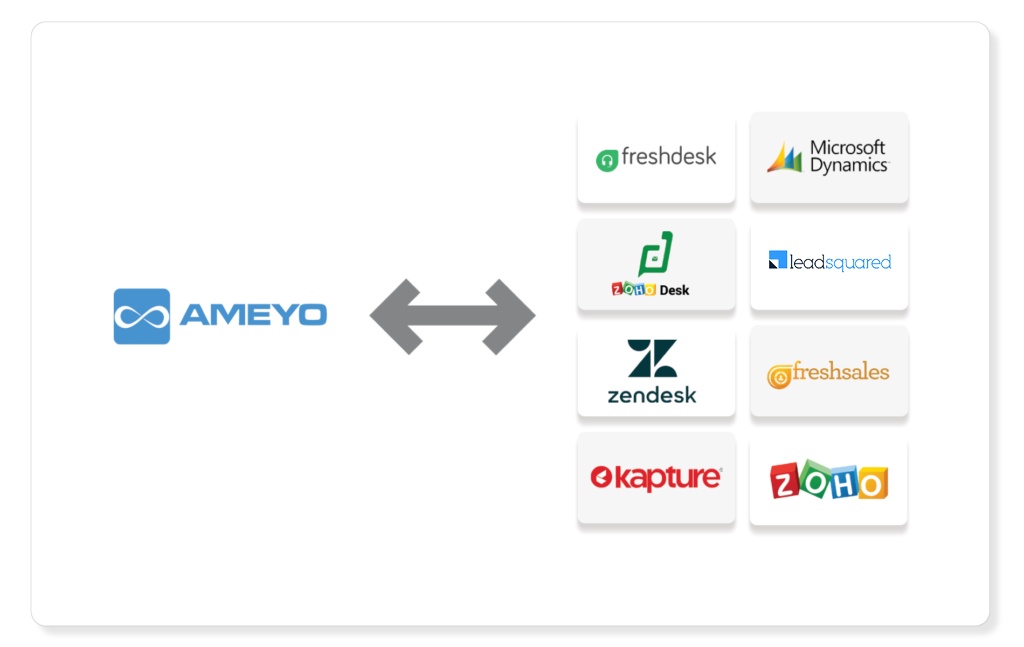
Trusted by more than 1600 customers spread throughout 40 countries, Ameyo is a worthy contender in the virtual call center software space. In addition to its virtual call center software, Ameyo also provides inbound and outbound call center, cloud contact center, and conversational AI solutions.
Its virtual software includes all the basic and advanced features you need to improve customer engagement, whether that’s through inbound or outbound calling. Notable features include call disposition, voice blasts, a preview dialer, and intelligent call routing with IVR and ACD. On the agent experience side, Ameyo is set up as a unified agent desktop so agents can handle tickets across channels in one consolidated dashboard.
Ameyo does not publish pricing information. To get more information about pricing, you’ll need to book a demo through the Ameyo website.
Pricing not available
Free trial: Not available
Features
- Predictive dialer
- On-call options (hold, mute, transfer, etc.)
- Call summary notes
- Mass notifications
- Number masking
- CRM integrations
- Call and screen recording
- Call center analytics
- ACD
- IVR
Learn more about Ameyo for Zendesk.
8.8×8

Many Zendesk customers use the 8×8 virtual contact center in combination with Zendesk to serve their customers more efficiently. Yet even on its own, 8×8 is a solution worth considering due to its powerful call handling capabilities, comprehensive configuration management, and seamless interface whether you’re using the software on a desk phone, desktop, or mobile device.
But 8×8 doesn’t just focus on call handling. The software also includes a suite of workforce engagement management tools including call volume forecasting, customer surveys, call recording, and real-time performance dashboards. If you opt for 8×8’s solution, you’ll have your choice between three plans ranging in price from $125 to $175 per user/month. You can save 25% on those monthly costs if you sign up for a yearly subscription.
Pricing
- Contact center X6: $125 per user/month
- Contact center X7: $138 per user/month
- Contact center X8: $175 per user/month
Free trial: 30 days
Features of Contact Center X6
- CRM
- Conferencing (video and audio)
- Reporting and analytics
- Skills-based routing
- Call recording
- IVR
- Call monitoring
Learn more about Zendesk for 8×8.
9.Genesys
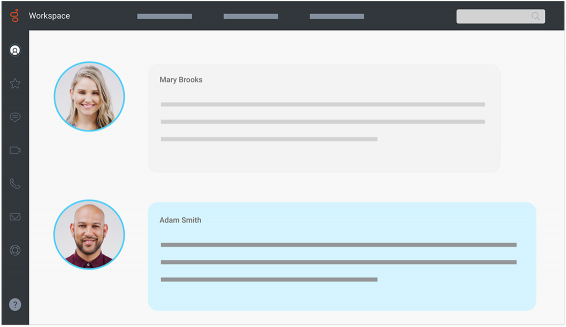
As part of their suite of contact center solutions, Genesys provides virtual call center software aimed at simplifying customer experiences across all channels. Genesys bills its software as a means to communicate quickly and seamlessly not just over the phone, but also through social media, your website, and live chat.
Genesys is capable of handling inbound and outbound calling and comes equipped with basic technologies like IVR and ACD for call routing. You can buy Genesys licenses in two ways, either with one of their three packages or with a custom software package. Their packages range from $75 to $150 per month and require a minimum commitment of $2000 per month.
Pricing
- Genesys Cloud CX 1: $75 per user/month
- Genesys Cloud CX 2: $110 per user/month
- Genesys Cloud CX 3: $150 per user/month
Free trial: 30 days
特性Genesys云残雪1计划
- Performance dashboards
- Real-time and historical reporting
- Inbound voice routing
- IVR and web callback
- Voicebots
Learn more about Zendesk for Genesys.
10.Bright Pattern
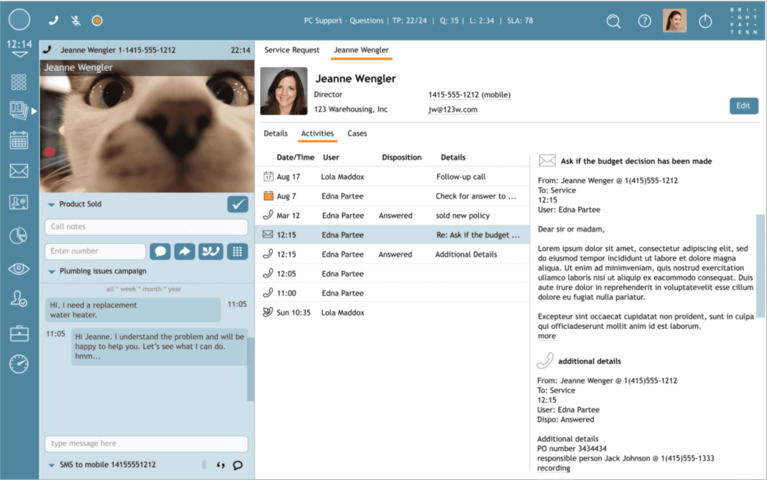
Featuring an impressive balance of sophistication and ease-of-use, Bright Pattern helps virtual call center agents leverage the power of embedded AI to ensure high-quality customer experiences. Bright Pattern also comes with a plethora of popular CRM integrations including connections with Zendesk, Salesforce, Oracle Service Cloud, and ServiceNow.
G2 reviews on Bright Pattern绝大多数是积极和少数- reviews seem relatively minor. The main positive feedback is that Bright Pattern’s service is quick and accurate, rarely goes down, and has strong out-of-the-box functionality. Pricing for Bright Pattern is not publicly available but they offer three packages which you can request a quote on their website.
Pricing not available
Free trial: 30 days
Features
- Inbound Voice Calls
- Outbound Voice Calls
- ACD
- IVR
- Callback
- Personal Routing
- Journey History
- Customer Profile
- Surveys
- Reporting and Customizable Dashboards
- 亚博官方app
- API Access
- Call Recording (90 Days)
- 屏幕录制(30天)
Learn more about Zendesk for Bright Pattern.
What are the essential features of a virtual call center software?
Call routing options
Much of the value of your virtual call center will come down to how efficiently calls are routed. So having plenty of smart call routing options is key. Generally, two key features determine how your call can be routed—automatic call distribution (ACD) andinteractive voice response(IVR).
IVR is the system that collects customer information by asking pre-recorded questions. Once customer info is collected, ACD kicks in. Based on the customer’s answers to the pre-recorded questions ACD routes calls based on preset rules.
These preset rules might be configured so customers are directed to the agent with the right skillset to serve them—this is calledskills-based routing.Other common forms of routing include:
- Round robin routing: calls are evenly distributed among agents.
- Time-based routing: calls are distributed based on the agent’s business hours.
- Called ID routing: pushes VIP callers to the head of the line.
- Predictive routing: AI-based routing that uses data to inform routing decisions.
Inbound and outbound calling
A call center isn’t much good to you if it can’t make the kinds of calls you need. Fortunately, every virtual call center solution has either inbound or outbound calling, and many have both. But you want to make sure the software and package you’re considering has the calling functionality you require. Oftentimes, if outbound and inbound calling aren’t both included, you can add the calling capabilities you need as an add-on.
Call center training tools
In our latest research,68 percent of customersindicated that it feels like most businesses need to improve their service agents’ training. And only 20% of agents feel extremely satisfied with the quality of their training.
That’s why in a modern virtual call center, tools likecall monitoring, call recording, and call whispering are more important than ever. Call monitoring enables agents’ managers to get a firsthand look at what’s going on and how their employees can improve. And call recording allows individual agents to look back on how things went and think about how they can improve.
Call whispering is also invaluable because it allows managers to coach their agents in real-time. Taken together, these three tools facilitate a more efficient and effective training process for agents and their managers.
What are the benefits of using a virtual call center service?
Improved employee experience
Virtual call center services provide the tech you need to allow service agents and their managers the flexibility to work remotely. And with the competition for competent service agents as hot as it’s ever been, workplace flexibility is a critical recruiting tool.
In fact, aPwC study in the USshows that 55% of workers want to work remotely for most of the week. Andanother study in the UKindicated that 51% of employees value job flexibility more highly than salary when making job choices.
So even if you don’t plan on going fully remote, virtual call center software enables invaluable flexibility.
Greater call center efficiency
Before the rise and proliferation of cloud-based tools like virtual call center software, outsourced, traditional call centers were the low-cost option. But outsourcing comes with its own costs. Foremost is the lack of quality control companies have when they outsource their call center function to a third party. But virtual call centers make it possible tocontrol costs without giving up so much controlof the customer experience.
Virtual call centers are more affordable than traditional call centers because they:
- Widen your hiring pool geographically to lower-cost markets.
- Lower the overhead associated with maintaining a traditional call center.
- Attract candidates at lower salaries
- Make training more efficient and less costly
- Reduce agent attrition
Seamless connectivity with other cloud-based tools
与传统的呼叫中心软件相比,virtual call center services are far easier to connect to your other cloud-based tools. Most virtual call center solutions havepre-built integrationswithpopular CRMs,helpdesks,analytics tools,ticket management solutions, and much more. These integrations help enhance both the agent and customer experience, making your virtual call center solution that much more powerful.
Of course, not all vendors have taken the same care in building effective, intuitive integrations. For example, you will find more thanone thousand pre-built integrationsfor Zendesk’s virtual call center while Aircall only has about one hundred as of this writing.
How to choose the best virtual call center solution for your business?
If you’re selecting a virtual call center solution for your business, you have many options—which is both a blessing and a curse. We recommend focusing your selection process on the following three areas:
Quality of fit with current team
For any software to be useful to your organization, it has to become an extension of your team, both in the current moment and the future. That means prioritizing solutions that can be configured around your current processes, rather than the other way around. But it’s not enough to just consider your current team’s constraints.
Both your team and your business will change over time, and that’s where theflexibility of your virtual call centerbecomes very important. After all, even the tools that are best for you today quickly become expensive if you have to switch from them once you grow, change your team organization, or pivot your business.
Expected return on investment
When you’re considering a solution, you can’t know exactly how it will impact your operations. But that shouldn’t stop you from making some ROI projections. To do this, decide on one or more areas where you’re aiming to generate income via improvedcustomer service.Typically, customer service generates income through upgrades on existing accounts,retaining accounts longer, and/or expanding via referrals. If you can pin down how new software might impact one of these revenue streams, you can start to calculate the ROI.
You can also evaluate how a given solution will lower costs through, for example, reduced headcount or improved employee retention. However you decide to calculate ROI, your projections can help contextualize the cost of each solution.
Speed and efficiency of deployment
If you’ve ever purchased a major software product in a corporate setting, you know that it’s not enough for your team to see the potential value. Executives and other stakeholders also need tosee the value.Otherwise funding and buy-in can quickly dry up. That’s why it’s so important to consider how long it will take for the virtual call center solution you choose to start creating tangible value. The sooner you can show the effectiveness of the tool, the easier it will be to integrate it within your organization.
Frequently asked questions
How can virtual call center solutions improve the customer experience?
Virtual call center solutions improve the customer experience by:
- Improving theagent experience, making them more engaged and energetic with customers.
- Enabling 24/7 service by making it possible for agents in different timezones to operate within the same call center.
- Speeding average resolution time by minimizing manual work for agents.
- Integrating with other tools that provide contextualcustomer dataand empower agents to provide more personalized service.
- Seamlessly linking other communication channels such associal media, live chat,SMS, and more.
How does a virtual call center software enhance agent productivity?
Virtual call center software enhances agent productivity by:
- Automatically routing calls based on preset rules related to agent skills and availability, customer information, and timezone.
- Providing context to the agent, such as order history, so they can tailor their service to the individual.
- Enabling agents to work from home with fewer distractions — according to aStanford study, home working led to a 13% performance increase for contact center agents.
Why are virtual call centers the future?
Virtual call centers are the future because they support a more modern way of working. Specifically, they allow for the type of cloud-based systems integration that is necessary for companies to make moredata-driven decisionsand provide more contextually relevant service. Going virtual with call centers also makes it possible for organizations to be more flexible and agile, which is increasingly important to attract and retain top talent.
What is the cost of a virtual call center solution?
The cost of your virtual call center consists of two main components: the IT cost of deploying and maintaining the software and the licensing cost.According to Nemertes, a global research-based advisory firm, companies with more than 500 agents spend $2,891 annually per agent and companies with less than 100 agents spend $4303 annually per agent.
How does integrations work in virtual contact center solutions?
How integrations work in virtual contact center solutions depends on the solution provider and your internal resources. Many, but not all, solution providers build native integrations to other popular applications, like thisZendesk and Salesforce integration.跟当地的集成,你连接你的古董al contact center to any tool that has a pre-built integration.
Otherwise, you’ll need to use APIs or a standalone integration platform to connect your virtual call center software to your other tools.
试试虚拟帐目ct center software for free
If you’re looking for a virtual call center solution, you need to try it first. So start a Zendesk trial today and start seeing how it can help you deliver better customer experiences.
Before you disconnect
Providing support over the phone is a skill all on it’s own. Learn how to do it well through some of our blog posts and resource articles.





